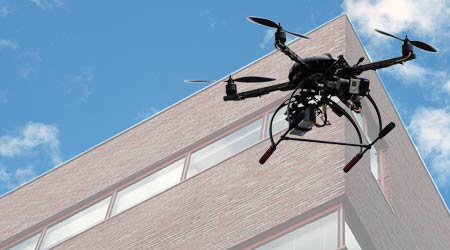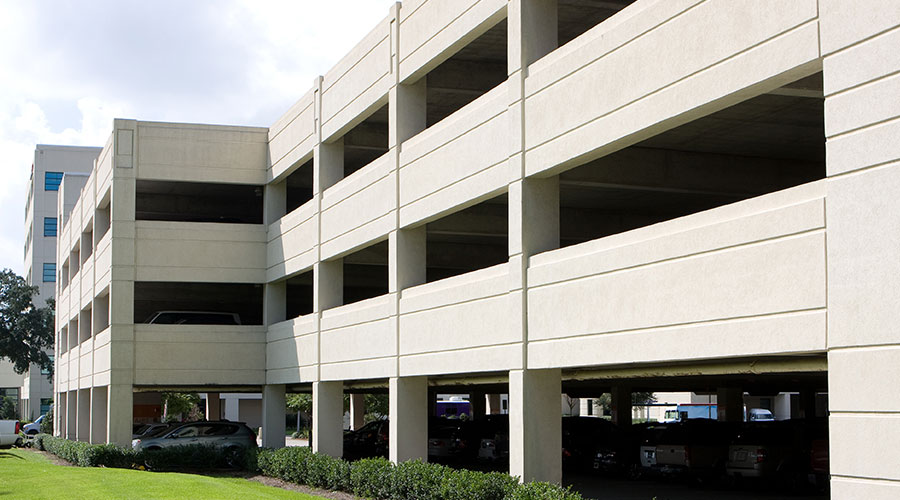Commercial Drones Give Managers Eyes in the Sky
Part one of a three-part article on commercial drones
That top-floor corner of the building’s façade, the one just out of reach of a ladder, that is starting to crack.
The huge, aging flat roof that has started leaking and has not been inspected properly in years.
That awkward interior section of the gymnasium ceiling where something bad — though it is not clear exactly what — is happening.
NFMT Session — Eyes in the Sky: Drones in Facility Management
Every maintenance and engineering manager wrestles with such areas. They are hard to access, show signs of major problems, and have not been properly addressed in years, if ever.
Technicians cannot reach them safely, and aerial work platforms and scaffolding are expensive and time-consuming to set up and take down, not to mention potentially dangerous to workers.
Enter the drone.
As new applications expand daily for commercial drones — also called unmanned aerial vehicles (UAVs) — managers are considering ways drones might be able to expand the reach and capabilities of their departments and technicians. They have only just begun.
Bonus: Drones — Flying Through Red Tape
“The benefits haven’t really been outlined to facility managers,” says Andrew Dennison, chief operating officer with Lift Technologies, a UAV services company in Chicago. “I don’t think a lot of them understand what they can get, and the drone operators really don’t understand what facility managers want. In six months to a year, as more of these conversations happen, they’ll start to get a better feel, and some new software services might help facility managers even more. It’s such a new market.”
To drone or not to drone
Just as infrared imaging a decade ago appealed to managers looking for new ways to see their facilities, commercial drones also challenge managers to understand possible applications by seeing their facilities differently.
“The most important question to ask is, ‘Do you have a management problem in an area that is difficult to reach that needs a lift to reach but that just needs periodic visual inspection?’ says David Kosnik, P.E., a senior engineer with CTLGroup, a consulting engineering firm in Naperville, Ill. “If that’s the case, indoors or outdoors, drones are an option you ought to consider.”
In addition to problem areas of facilities, managers also can review their front-line technicians’ daily activities to determine whether and how a drone’s capabilities could extend technicians’ reach.
“Managers should look at (technicians’) regular tasks and ask if a drone could assist in the task,” says Michael Petermann, principal with Wiss, Janney, Elstner Associates in New York City. “In most cases, inspection services are what will jump to mind first, such as façade and roof inspections. But all hard-to-reach areas should be considered, including smoke stacks, chimneys, and antennae. Essentially, anywhere a boom lift or scaffolding is used should be evaluated for use of a drone.
“This is not limited to exterior surfaces. Drones can be flown indoors, which are typically not subject to regulations. Depending on the indoor space configuration, a drone may be the only practical method of getting up close to the subject area.”
Given the relative novelty of drones, as well as evolving regulatory requirements from the Federal Aviation Administration (FAA), it is not surprising that managers in institutional and commercial facilities have moved slowly in investigating possible applications.
“We haven’t seen much interest yet from the low-rise buildings for façade inspections, and I don’t expect to see much interest, at least immediately, which is a shame,” Petermann says. “One benefit is that you can have your drone record video, and you can store that video. As long as you automate the pattern or the process, you can repeat the flight. Then you have side-by-side results over a period of time. This can be very useful in monitoring the behavior of a façade.
“The more immediate use for low-rise buildings might be doing roof scans. The major hurdle with that is that the FAA prohibits any nighttime flying. Nighttime is a consideration because the first thought is to run an infrared camera from a drone platform (during the day) and then run the scan at night. If there is a temperature differential, then we can see where potential leaks are or if there are problems with the assembly.”
Nonetheless, consultants offering commercial drone services say it is only a matter of time until managers begin giving drones more serious consideration, given the technology’s potential benefits.
“I’m not aware of specific interest (among education and health care facilities), but I think it will come up,” Kosnik says. “We’re going to start bringing it to our clients as part of our initial site assessment to try to reduce our costs associated with access. Setting up a swing stage to inspect an envelope on a 20-story building is no small matter. I think our clients will be pleased to focus our work better because of the use of drone imagery.”
Related Topics:













